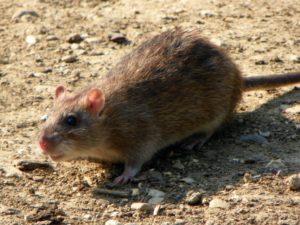 The Norway rat, roof rat, and house mouse are destructive rodent pests in and around farm facilities. This can be especially true during the winter months, as they seek food and refuge indoors. Rats and mice consume and contaminate food, gnaw on structural, mechanical, and electrical components, and weaken concrete slabs and walkways with their burrowing activities. They can also potentially carry diseases such as bubonic plague, leptospirosis, rabies, and bacterial food poisoning.
The Norway rat, roof rat, and house mouse are destructive rodent pests in and around farm facilities. This can be especially true during the winter months, as they seek food and refuge indoors. Rats and mice consume and contaminate food, gnaw on structural, mechanical, and electrical components, and weaken concrete slabs and walkways with their burrowing activities. They can also potentially carry diseases such as bubonic plague, leptospirosis, rabies, and bacterial food poisoning.
Usually, the first signs of rodent infestation are droppings or urine stains in and around buildings, because rats and mice are most active at night. If rodents are seen repeatedly during the day, it is an indication of an established population. It is estimated that for every rodent seen during the day around barns and poultry houses, there are likely 20 to 50 that are unseen.
Effective rodent control involves a three-step process. The first step is to “rodent-proof” the structure. This is very difficult because rats and mice can squeeze through holes just large enough to pass their heads through, as small as ¼ for mice and ½ inch for rats. They can climb through pipes; jump vertically three feet, horizontally four feet, and climb wires, cables, vines, and trees to enter a building.
Rats and mice have long been a problem on farms where food and nesting sites are plentiful. They are carriers of some 45 diseases and are capable of contaminating farm feed and water supplies helping to spread disease from contaminated to uncontaminated areas and from animal to animal. Many of these diseases are harmful to livestock and humans.
Evidence for pest menace,
Food bank warehouse infested with rats, state inspector finds
By Jeff Ostrowski
Posted Feb 3, 2020
The Palm Beach County Food Bank could face the loss of its food permit after a state inspector found “a heavy accumulation of rat excreta” at the nonprofit’s facility in Lantana in late January. In September 2019, an inspector found mouse droppings.
The Palm Beach County Food Bank could face the loss of its food permit after a state inspector found overwhelming evidence of a rat infestation at the nonprofit’s facility in Lantana.
An inspector from the Florida Department of Agriculture and Consumer Services visited the Palm Beach County Food Bank on Jan. 24 and reported the facility was overrun by rodents.
“A heavy accumulation of rat excreta too numerous to count were observed on the floor, pallets, chairs, metal lifts and metal shelves in the main dry good storage warehouse,” the report said.
The inspector also saw rat feces in a walk-in refrigerator. During the Jan. 24 visit, rat droppings littered the staff kitchen.
SLO Food Bank: Health inspectors found rodent droppings at the warehouse
By KSBY
The Food Bank Coalition of San Luis Obispo County released more information Monday related to the unsanitary conditions health inspectors say were found at the organization’s warehouse last month.
Food Bank CEO Kevin Drabinski says after staff failed to renew its processed food registration license at its new San Luis Obispo warehouse, state health inspectors came out November 27 to check out the facility.
It was at that time Drabinski says evidence of rodent droppings were discovered at various locations throughout the warehouse. The food bank was then told no products could be moved in or out of the facility until further notice.
Using of pesticides, rat baits, fumigation, glue board can be harmful to human’s health so instead of using an outdated control measure like the pesticides, we can make use of our products which repels.
We at C Tech Corporation are in a unique position to provide solutions to the problems caused by these creatures.
At C Tech Corporation we make use of Mother Nature’s gift of senses to these rodents in developing non- toxic & non-hazardous formulation!
RodrepelTM is a low-toxic, non-hazardous rodent aversive. RodrepelTM is a perfect blend of smart technology and green chemistry. This product acts through a series of highly developed intricate mechanism ensuring that the rodents are kept away from the application.
Our eco-friendly products do not kill the target species but only repel them.
Our products are available in the form of a liquid concentrate, lacquer, wood polish additives, masterbatch, and spray.
RodrepelTM liquid concentrate, when diluted in paints, can be used to paint the interior and exterior of the walls of the warehouse, storage areas, ceiling, panels, mechanical equipment, vehicles used for transportation.
RodrepelTM lacquer can be coated topically over the applications which need protection. It can be applied to a variety of surfaces like wood, furniture, concrete, metal, polymeric utility pipes, and ceramic. It can be applied to the wooden accessories in the warehouse, already installed wires and cables
RodrepelTM wood polish additives can be applied as a topical application by mixing it with wood polish. It can also be applied to racks, pallets, furniture, etc.
RodrepelTM masterbatch can be incorporated in pipes, films, wires, cables, polymeric material, instruments, racks, pallets, grain bags, etc.
Our newly developed product in the form of a spray can be applied to the racks, pallets, already installed cables and wires, furniture, etc.
Our products provide a safe and environmentally friendly solution to avoid rodent infestation.
If you are facing problems from the sneaky pests that contact us on:
technical.marketing@ctechcorporation.com
Also, visit our websites:
http://www.ctechcorporation.com/
http://www.rodrepel.com/
http://www.termirepel.com/
http://www.combirepel.com/
Follow our Facebook pages at:
1] https://www.facebook.com/Combirepel-411710912249274/
2] https://www.facebook.com/Termirepel-104225413091251/
3] https://www.facebook.com/Rodrepel-120734974768048/
Follow us on our Twitter pages at:
1] https://twitter.com/rodrepel
2] https://twitter.com/termirepel
3] https://twitter.com/combirepel
